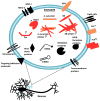Extracellular vesicles including exosomes are mediators of signal transduction: are they protective or pathogenic?
- PMID: 25307053
- PMCID: PMC4419270
- DOI: 10.1002/pmic.201400234
Extracellular vesicles including exosomes are mediators of signal transduction: are they protective or pathogenic?
Abstract
Extracellular vesicles (EVs) are signaling organelles that are released by many cell types and is highly conserved in both prokaryotes and eukaryotes. Based on the mechanism of biogenesis, these membranous vesicles can be classified as exosomes, shedding microvesicles, and apoptotic blebs. It is becoming clearer that these EVs mediate signal transduction in both autocrine and paracrine fashion by the transfer of proteins and RNA. While the role of EVs including exosomes in pathogenesis is well established, very little is known about their function in normal physiological conditions. Recent evidences allude that EVs can mediate both protective and pathogenic effects depending on the precise state. In this review, we discuss the involvement of EVs as mediators of signal transduction in neurodegenerative diseases and cancer. In addition, the role of EVs in mediating Wnt and PI3K signaling pathways is also discussed. Additional findings on the involvement of EVs in homeostasis and disease progression will promote a better biological understanding, advance future therapeutic, and diagnostic applications.
Keywords: Animal proteomics; Exosomes; Extracellular vesicles; Microvesicles; Neurodegenerative diseases; Tumor microenvironment.
© 2014 WILEY-VCH Verlag GmbH & Co. KGaA, Weinheim.
Conflict of interest statement
The authors have declared no conflict of interest
Figures



References
-
- Thery C, Zitvogel L, Amigorena S. Exosomes: composition, biogenesis and function. Nat Rev Immunol. 2002;2:569–579. - PubMed
-
- Mathivanan S, Ji H, Simpson RJ. Exosomes: extracellular organelles important in intercellular communication. J Proteomics. 2010;73:1907–1920. - PubMed
-
- Simpson RJ, Mathivanan S. Extracellular Microvesicles: The Need for Internationally Recognised Nomenclature and Stringent Purification Criteria. J Proteomics Bioinform. 2012;5:ii–ii.
-
- Thery C, Amigorena S, Raposo G, Clayton A. Isolation and characterization of exosomes from cell culture supernatants and biological fluids. Curr Protoc Cell Biol. 2006;Chapter 3(Unit 3):22. - PubMed
Publication types
MeSH terms
Substances
Grants and funding
LinkOut - more resources
Full Text Sources
Other Literature Sources
Medical

